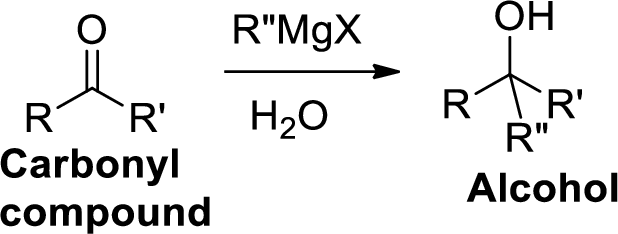
Interpretation:
The reagent has to be given for the conversion of A to Tamoxifen.
Concept introduction:
The Grignard reaction:
Alkyl, vinyl, or aryl-magnesium halides (
Grignard reagent is reaction with carbonyl compound such as

Dehydration reaction:
Removal of water molecule from the reaction when the alcohol is treated with strong acid like sulfuric acid.

Alcohol is reaction with concentrated sulfuric acid, first alcohol gets protonated forms carbocation (more stable carbocation) followed by elimination of proton (
Tertiary carbocation is more stable than the secondary, secondary carbocation is more stable than primary.

In dehydration reaction, sulfuric acid is act as a proton donor, and which is used to protonate the alcohol and makes carbocation therefore sulfuric acid is the driving force of the reaction. Dehydration reaction will not go without acid (sulfuric acid).
Want to see the full answer?
Check out a sample textbook solution
Chapter 21 Solutions
Organic Chemistry
- What metabolic reaction is illustrated by the image below? * СООН СООН -OCOCH3 CH,COOH он + Ester hydrolysis Decarboxylation Nitro- reduction Deamination Azo reductionarrow_forward4. Which effect does an antagonistic drug have? (a) It inhibits the activity of an enzyme (b) It promotes the activity of an enzyme (c) It inhibits the signalling of a receptor (d) It promotes the signalling of a receptor (e) It promotes nerve signalling 7. Which technique is not used for structural analyses of possible lead compounds? (a) NMR (b) IR (c) X-Ray crystallography (d) MRI (e) MSarrow_forwardWhy is methyl salicylate so easily absorbed through the skin?arrow_forward
- Paroxetine (Paxil) is an antidepressant that is a member of a family of drugs known as Selective Serotonin Reuptake Inhibitors (SSRIS). This family of drugs also includes fluoxetine (Prozac) and sertraline (Zoloft). SSRIS work by inhibiting the reuptake of the neurotransmitter serotonin in the synapses of the central nervous system follow- ing release of serotonin during excitation of individual nerve cells. Between firings, the serotonin is taken back up by a nerve cell in preparation for firing again. Inhibition of reuptake has the effect of increasing the time serotonin molecules remain in the syn- apses following excitation, leading to a therapeutic effect. In one synthesis of parox- etine, the following reagents are used. Draw the structures of synthetic intermediates A and B. F НО SOCI, A B HO Pyridinearrow_forwardBisphenol A is widely used as a building block in polymer synthesis and is found in the polycarbonate hard plastics of reusable drink containers, DVDs, cell phones, and other consumer goods. Bisphenol A is reported to have estrogenic activity, and its widespread occurrence in our environment is a potential concern. Describe one or two biochemical experiments that could be done to compare the activity of bisphenol A with that of its estradiol, its structural relative.arrow_forwardWhat are the safety hazards of these chemicals Acetic anhydride (108-24-7) Formic acid (64-18-60) Benzotriazole (95-14-7) N-Formylbenzotriazole (72773-04-7)arrow_forward
- Identify 3 structural features of this compound that are important to the medicinal chemist and tell how they might impact binding to a biological receptorarrow_forward(i)What class of drug is Ranitidine? (ii)If water contains dissolved Ca2+ ions, out of soaps and synthetic detergents, which will you use for cleaning clothes? (iii)Which of the following is an antiseptic? 0.2% phenol, 1% phenolarrow_forward¨ What other types of analgesics are on the market? How does their action compare with aspirin and why are these alternative drugs necessary? Discuss the differences among the following compounds by drawing their structures: Acetylsalicylic acid, Acetaminophen (Paracetamol), Ibuprofen, Paracetamol and Phenacetin.arrow_forward
- Write the chemical equation for the acid dissociation of acetaminophen, C8H9O2N. Write the Ka expression for the acid dissociation of acetaminophen.arrow_forwardWhich of the following are descriptions of possible starting material for this reaction? ? trace acid an ester a ketone an imine an aldehyde a carboxylic acid an enamine a primary amine a secondary amine a tertiary amine H Iarrow_forward8 (Chemical Connections 19C) Once it has been opened, and particularly if it has been left open to the air, a bottle of aspirin may develop a vinegar-like odor. Explain how this might happen.arrow_forward
 Organic ChemistryChemistryISBN:9781305580350Author:William H. Brown, Brent L. Iverson, Eric Anslyn, Christopher S. FootePublisher:Cengage Learning
Organic ChemistryChemistryISBN:9781305580350Author:William H. Brown, Brent L. Iverson, Eric Anslyn, Christopher S. FootePublisher:Cengage Learning Introduction to General, Organic and BiochemistryChemistryISBN:9781285869759Author:Frederick A. Bettelheim, William H. Brown, Mary K. Campbell, Shawn O. Farrell, Omar TorresPublisher:Cengage Learning
Introduction to General, Organic and BiochemistryChemistryISBN:9781285869759Author:Frederick A. Bettelheim, William H. Brown, Mary K. Campbell, Shawn O. Farrell, Omar TorresPublisher:Cengage Learning Chemistry & Chemical ReactivityChemistryISBN:9781337399074Author:John C. Kotz, Paul M. Treichel, John Townsend, David TreichelPublisher:Cengage Learning
Chemistry & Chemical ReactivityChemistryISBN:9781337399074Author:John C. Kotz, Paul M. Treichel, John Townsend, David TreichelPublisher:Cengage Learning Chemistry & Chemical ReactivityChemistryISBN:9781133949640Author:John C. Kotz, Paul M. Treichel, John Townsend, David TreichelPublisher:Cengage Learning
Chemistry & Chemical ReactivityChemistryISBN:9781133949640Author:John C. Kotz, Paul M. Treichel, John Townsend, David TreichelPublisher:Cengage Learning EBK A SMALL SCALE APPROACH TO ORGANIC LChemistryISBN:9781305446021Author:LampmanPublisher:CENGAGE LEARNING - CONSIGNMENT
EBK A SMALL SCALE APPROACH TO ORGANIC LChemistryISBN:9781305446021Author:LampmanPublisher:CENGAGE LEARNING - CONSIGNMENT Chemistry for Today: General, Organic, and Bioche...ChemistryISBN:9781305960060Author:Spencer L. Seager, Michael R. Slabaugh, Maren S. HansenPublisher:Cengage Learning
Chemistry for Today: General, Organic, and Bioche...ChemistryISBN:9781305960060Author:Spencer L. Seager, Michael R. Slabaugh, Maren S. HansenPublisher:Cengage Learning





